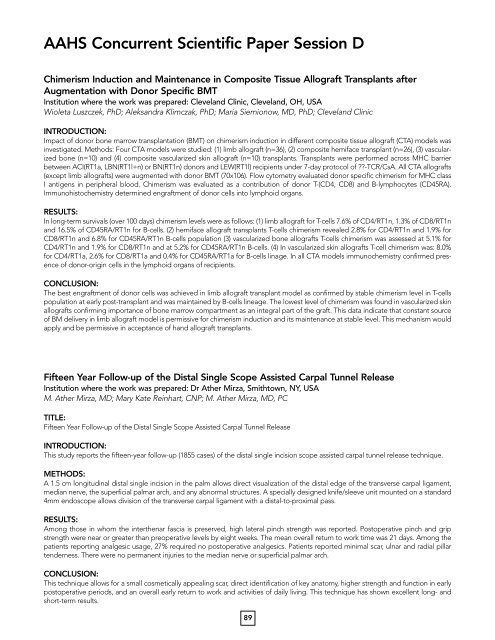Floor plan - 2013 Annual Meeting - American Association for Hand ...
Floor plan - 2013 Annual Meeting - American Association for Hand ...
Floor plan - 2013 Annual Meeting - American Association for Hand ...
Create successful ePaper yourself
Turn your PDF publications into a flip-book with our unique Google optimized e-Paper software.
AAHS Concurrent Scientific Paper Session D<br />
Chimerism Induction and Maintenance in Composite Tissue Allograft Trans<strong>plan</strong>ts after<br />
Augmentation with Donor Specific BMT<br />
Institution where the work was prepared: Cleveland Clinic, Cleveland, OH, USA<br />
Wioleta Luszczek, PhD; Aleksandra Klimczak, PhD; Maria Siemionow, MD, PhD; Cleveland Clinic<br />
INTRODUCTION:<br />
Impact of donor bone marrow trans<strong>plan</strong>tation (BMT) on chimerism induction in different composite tissue allograft (CTA) models was<br />
investigated. Methods: Four CTA models were studied: (1) limb allograft (n=36), (2) composite hemiface trans<strong>plan</strong>t (n=26), (3) vascularized<br />
bone (n=10) and (4) composite vascularized skin allograft (n=10) trans<strong>plan</strong>ts. Trans<strong>plan</strong>ts were per<strong>for</strong>med across MHC barrier<br />
between ACI(RT1a, LBN(RT1l+n) or BN(RT1n) donors and LEW(RT1l) recipients under 7-day protocol of ??-TCR/CsA. All CTA allografts<br />
(except limb allografts) were augmented with donor BMT (70x106). Flow cytometry evaluated donor specific chimerism <strong>for</strong> MHC class<br />
I antigens in peripheral blood. Chimerism was evaluated as a contribution of donor T-(CD4, CD8) and B-lymphocytes (CD45RA).<br />
Immunohistochemistry determined engraftment of donor cells into lymphoid organs.<br />
RESULTS:<br />
In long-term survivals (over 100 days) chimerism levels were as follows: (1) limb allograft <strong>for</strong> T-cells 7.6% of CD4/RT1n, 1.3% of CD8/RT1n<br />
and 16.5% of CD45RA/RT1n <strong>for</strong> B-cells. (2) hemiface allograft trans<strong>plan</strong>ts T-cells chimerism revealed 2.8% <strong>for</strong> CD4/RT1n and 1.9% <strong>for</strong><br />
CD8/RT1n and 6.8% <strong>for</strong> CD45RA/RT1n B-cells population (3) vascularized bone allografts T-cells chimerism was assessed at 5.1% <strong>for</strong><br />
CD4/RT1n and 1.9% <strong>for</strong> CD8/RT1n and at 5.2% <strong>for</strong> CD45RA/RT1n B-cells. (4) In vascularized skin allografts T-cell chimerism was: 8.0%<br />
<strong>for</strong> CD4/RT1a, 2.6% <strong>for</strong> CD8/RT1a and 0.4% <strong>for</strong> CD45RA/RT1a <strong>for</strong> B-cells linage. In all CTA models immunochemistry confirmed presence<br />
of donor-origin cells in the lymphoid organs of recipients.<br />
CONCLUSION:<br />
The best engraftment of donor cells was achieved in limb allograft trans<strong>plan</strong>t model as confirmed by stable chimerism level in T-cells<br />
population at early post-trans<strong>plan</strong>t and was maintained by B-cells lineage. The lowest level of chimerism was found in vascularized skin<br />
allografts confirming importance of bone marrow compartment as an integral part of the graft. This data indicate that constant source<br />
of BM delivery in limb allograft model is permissive <strong>for</strong> chimerism induction and its maintenance at stable level. This mechanism would<br />
apply and be permissive in acceptance of hand allograft trans<strong>plan</strong>ts.<br />
Fifteen Year Follow-up of the Distal Single Scope Assisted Carpal Tunnel Release<br />
Institution where the work was prepared: Dr Ather Mirza, Smithtown, NY, USA<br />
M. Ather Mirza, MD; Mary Kate Reinhart, CNP; M. Ather Mirza, MD, PC<br />
TITLE:<br />
Fifteen Year Follow-up of the Distal Single Scope Assisted Carpal Tunnel Release<br />
INTRODUCTION:<br />
This study reports the fifteen-year follow-up (1855 cases) of the distal single incision scope assisted carpal tunnel release technique.<br />
METHODS:<br />
A 1.5 cm longitudinal distal single incision in the palm allows direct visualization of the distal edge of the transverse carpal ligament,<br />
median nerve, the superficial palmar arch, and any abnormal structures. A specially designed knife/sleeve unit mounted on a standard<br />
4mm endoscope allows division of the transverse carpal ligament with a distal-to-proximal pass.<br />
RESULTS:<br />
Among those in whom the interthenar fascia is preserved, high lateral pinch strength was reported. Postoperative pinch and grip<br />
strength were near or greater than preoperative levels by eight weeks. The mean overall return to work time was 21 days. Among the<br />
patients reporting analgesic usage, 27% required no postoperative analgesics. Patients reported minimal scar, ulnar and radial pillar<br />
tenderness. There were no permanent injuries to the median nerve or superficial palmar arch.<br />
CONCLUSION:<br />
This technique allows <strong>for</strong> a small cosmetically appealing scar, direct identification of key anatomy, higher strength and function in early<br />
postoperative periods, and an overall early return to work and activities of daily living. This technique has shown excellent long- and<br />
short-term results.<br />
89



